July
14, 2000
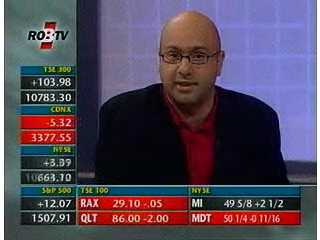 Quicktime
Video of Interview:
Quicktime
Video of Interview:
Smaller
- Dial-up modem
Larger - Broadband (Cable, DSL, T1)
MP3
Audio of Interview:
ROBTV
(Ali
Velshi): Well, it's an exciting week for tech. We've been
bringing you the highlights from COMDEX Conference, a showcase of
the latest technological innovations and every gadget-head's dream
come true.
Well,
Edgar Matias, President of Matias Corporation and the inventor of
the Matias Half Keyboard, is here (not at COMDEX) to show us the latest
in mobile computing.
Welcome
to the show.
Edgar
Matias: Thanks.
ROBTV:
Now tell me what the Half Keyboard is and when the other half is coming
out?
Edgar
Matias: Okay. You don't need the other half. It's basically half
of a regular keyboard and it lets you touch type with one hand, using
your existing skills.
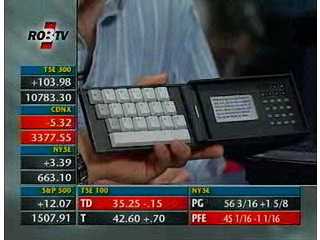
ROBTV:
Alright, let's take a look at this, this little unit.
So this
is the Half Keyboard. Uh, actually I'll show it to the screen like
that.
Alright
now, what does this do? What is this?
Edgar
Matias: This is an industrial model of a product we're working
on. It's a handheld appliance. You'll be able to take notes with it,
and then upload all the notes you've taken onto a laptop or desktop
computer.
ROBTV:
What's the advantage of this not having the other half of the keyboard?
Edgar
Matias: The main advantage is size. You can make a handheld machine
that has roughly the same functionality as a desktop machine or a
laptop, as long as you have a keyboard that's good for word processing,
and this one will allow you to do that, using your existing skills.
ROBTV:
Alright, now tell me how it works.
Edgar
Matias: Okay, basically...
ROBTV:
Because my main question is, you're missing half the keyboard, so...
Edgar
Matias: Sure
ROBTV:
... You can only, like... Think you can get my full name out of there?
Edgar
Matias: Yeah.
ROBTV:
Oh, you can.
Edgar
Matias: Okay, I'm going to use my right hand. This is a demo that
we have, that is on our website as well. I'm used to my left, but
I'll use my right...
ROBTV:
Now this is the software. You're operating on the software that would
come with this.
Edgar
Matias: Yeah, exactly. This is the software equivalent of what
we're going to be selling, and basically the way it works...
You
type just like you would on a normal keyboard for the hand that you're
using to type. So it's just like regular typing for that hand.

But
when you want to do the letters of the other hand, instead of using
the other hand, you hold down the space bar. And when you do that,
you'll notice it takes all the letters from the other side of the
keyboard and maps them onto the side that you're typing on.
ROBTV:
I'm going to (just for our viewers) explain to them that while you're
typing this on a keyboard, a proper keyboard, you're only using half
of it, like you'd be using a half keyboard here.
Edgar
Matias: Yeah, exactly.
ROBTV:
You're typing your name "Edgar Matias was here" and you're typing
it with half of the keyboard and you're alternating between one half
and the other, by pressing the space bar.
Edgar
Matias: Yeah, exactly.
ROBTV:
Now, a guy like me, I don't know if you've ever seen me type, but
I type like this... I don't know if the camera can see me, but I type
like this...
Well
I use two fingers on a keyboard. So this is not a product for a guy
like me. This is for somebody who's...
Edgar
Matias: A touch typist basically, yes.
ROBTV:
A touch typist. Needs a full keyboard. Lots of data entry.
Edgar
Matias: Yeah, our first market is the university student market.
Most of those people know / learned how to type in high
school.
Um,
we also have a few other markets we're pursuing, including the Internet
cellphone market...
One
model of the keyboard, if you can see this, is the same size as a
cellphone.

ROBTV:
Alright, let's hold that up. Okay yeah, you can see that on the screen.
Sorry, I should...
Edgar
Matias: So, there's no legends on these keys, but basically that's
all you need to do a cellphone-sized version of this.
ROBTV:
Okay.
Edgar
Matias: And you'd be able to type at speeds as high as 64 words
a minute, with one hand, on something the size of your cellphone.
ROBTV:
What's it gonna cost? If you're aiming it at university students,
what's it gonna cost?
Edgar
Matias: [pointing to handheld appliance] Uh, this is gonna cost
$350 Canadian or $250 American, when it comes out.
ROBTV:
This is the handheld Half Keyboard.
Edgar
Matias: Yeah, we're also looking at putting out an external keyboard
for the Palm device, and that's gonna sell for about $150 Canadian
or $100 American.
ROBTV:
Alright, now I understand you've got something up your sleeve...
Edgar
Matias: Yes I do. I was hoping I could sneak this past your audience.
This is a wearable computer.
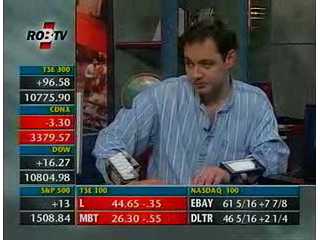
[Edgar
Matias rolls up sleeves, revealing Wearable Half Keyboard computer
system]
Let
me just turn it on here... There we go...
ROBTV:
And uh, this is for situations where you have very...
Edgar
Matias: Can you see that?
ROBTV:
So you're typing... We're just going to pull that camera in on that
keyboard there, that you've got on your arm...
Edgar
Matias: Sure.
ROBTV:
You're typing on your left hand.
Okay,
let's see if we can catch that...
There
you go, yeah.
Edgar
Matias: Alright...
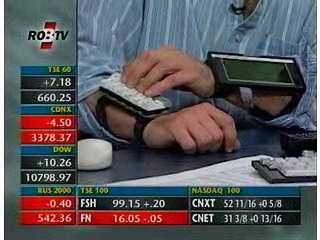
ROBTV:
Alright. So you're typing with your uh... with your... right... left...
Yeah, why would you do this?
Edgar
Matias: You would do this in situations where you wanted to have
access to a computer but you didn't have a desk; you didn't have a
power source. Anything that requires access to a computer, or the
information that's on a computer, in a mobile situation.
ROBTV:
Which means you're in a field or you're, I don't know, a census taker
or a factory worker?
Edgar
Matias: Exactly. Field work, inventory. The nice thing about this
is that when you're not using it, your hands are free.
I can
still pick things up. I can point at things, move things around.
This
one's a little rough-looking, because it's a prototype.
The
actual version that we're looking at putting out would use a pen-based
handheld device, and there'd just be a wire running across to the
keyboard portion.
Wearable
computers typically cost in the C$7,500 range, for an industrial wearable
computer.
Using
this design, you could easily build one for under C$1,000.
ROBTV:
Alright, and how are these two things connected? Are you wearing a
wire on you or something?
Uh,
yeah there's a wire.
ROBTV:
Alright, so, you... When you say a pen-based computer on your left
hand or whatever hand it is, you mean like a...
It's
like a Palm unit, or one something like that?
Edgar
Matias: Yeah, exactly.
ROBTV:
You have the option of typing and enter text.
Edgar
Matias: Yeah, exactly.
ROBTV:
Okay, quite facinating. We don't have too much time... Do you think
there's a big market for this?
Edgar
Matias: Oh yeah, for sure. We're looking at around a $90 Billion
market for handheld word processing, and on top of that the Internet
phone and the wearable market is going to materialize as well.
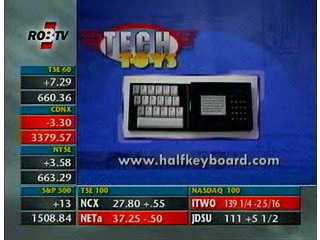
ROBTV:
Edgar, this looks very exciting. Thank you for coming to show it to
us, and we will just... If you need more information on this, we've
got some information for you right now: www.halfkeyboard.com
We're
taking a quick break. We'll be back in 2 minutes.
Copyright
© 2000 Globe
Interactive
Portions copyright © 2000 ROBTv
All Rights Reserved.



